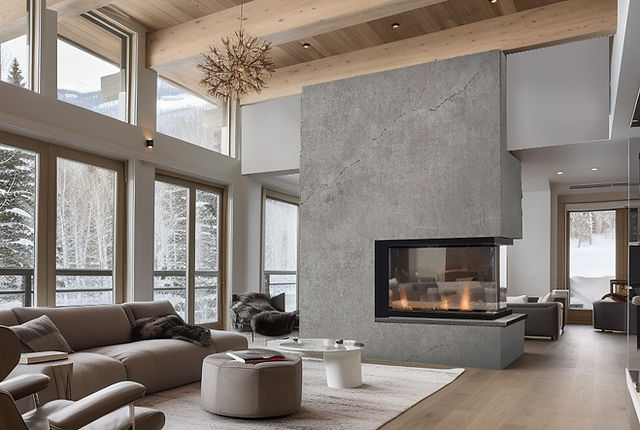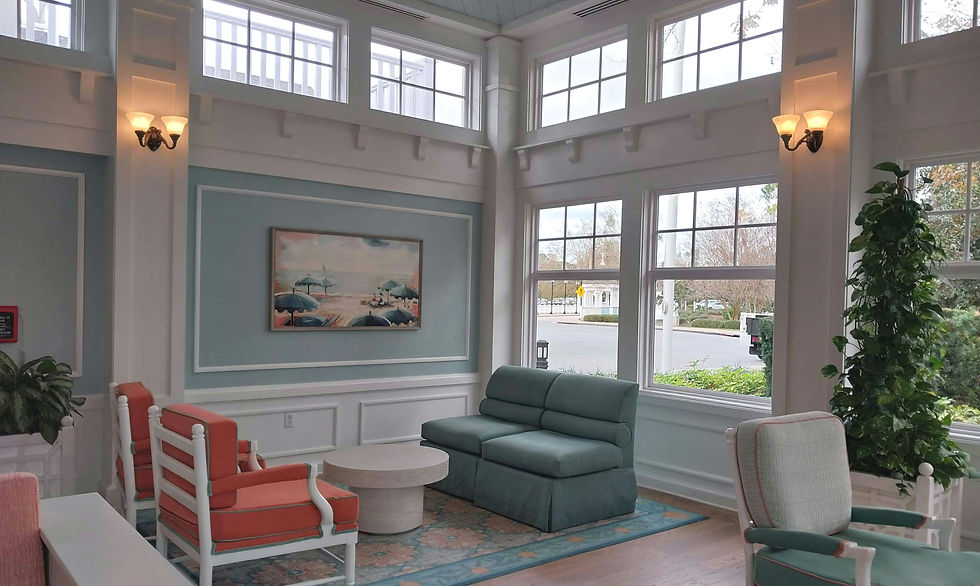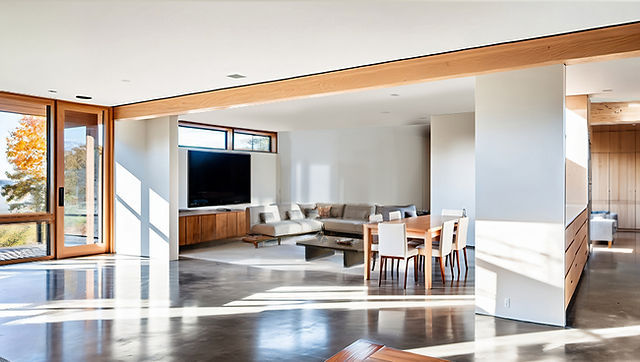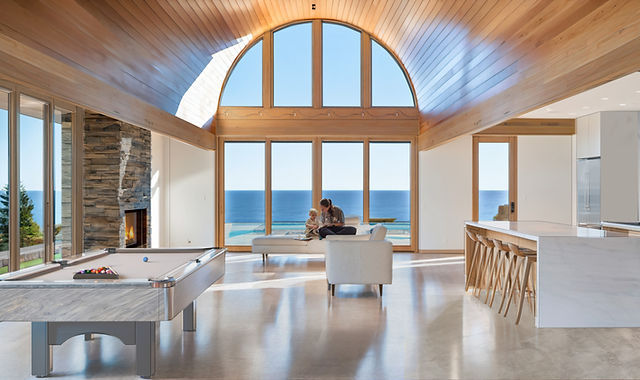Utilizing sunlight is one of the essential goals of architecture. In this article we will break down how we determine good lighting and explore how deeply connected this matter is to our health and well-being. Understanding the metrics used to measure light, such as lumens and foot candles, helps tailor lighting to specific needs. Lumens quantify the total visible light emitted by a source, while foot candles measure light intensity on surfaces.
Below is an example of one of our favorite projects. This interior has tall windows, facing a northwest angle. The bright sunlight on the mountain makes the space bright and stunning.

(Studio North Homes 'Stratton Ski Chalet' project)
Task-Oriented Lighting
Different activities require varying light levels:
Reading and Writing: Optimal lighting ranges from 500 to 100 lux (approximately 50 to 100 foot candles).

(photo of a Solarium with a 500 lux light meter reading by the east facing windows, 1 p.m. Location: Disney Beach Club resort)
Play and Socializing: A range of 150 to 250 lux (around 15 to 25 foot candles) suffices for these activities.
Lighting for Plant Growth: Indoor plants typically require 2,000 to 10,000 lux (foot candles of light), depending on the species. Conservatories, serving as plant havens, often necessitate ample natural light to simulate outdoor conditions conducive to various plant types.
Understanding Diffused Light and Orientation
Diffused light, often achieved through north-facing windows or indirect sources, spreads evenly across a room, minimizing harsh shadows and glare. Northern exposure tends to provide softer, consistent light, contrasting with the direct, intense sunlight typical of southern exposure.

(Studio North Homes 'Skyline' project)
Psychological Impact of Well-lit Spaces
Scientific studies, such as those by the Journal of Environmental Psychology and the International Journal of Environmental Research and Public Health, highlight the positive psychological effects of well-lit architectural spaces. These spaces contribute to improved mood, increased productivity, and better overall well-being.

(north facing Solarium at Beach Club Disney Resort)
Age-Related Changes in Perception
As individuals age, changes in retinal function can lead to decreased perception of brightness in spaces. This phenomenon, observed in studies like those published in JAMA Ophthalmology, can impact mental health by affecting one's perception of the surrounding environment and may lead to a sense of decreased brightness, potentially impacting mood and cognitive well-being.

(south-east facing light corridor of Studio North Homes 'Wave House's project)
Natural vs. Artificial Lighting
The power of natural lighting transcends its functional aspects. Studies published in Lighting Research & Technology and the Journal of Clinical Sleep Medicine highlight how natural light positively influences circadian rhythms, sleep patterns, and overall health. Its ability to mimic the sun's spectrum positively affects mood and can contribute to increased productivity and a better sense of well-being compared to artificial lighting sources.
So what does this mean for Architecture?
Harnessing Angles for Light Diffusion in Architecture
In architectural design, the manipulation of angles and structural features plays a pivotal role in diffusing light throughout spaces. Various architectural elements can be strategically employed to achieve optimal light diffusion:

(Studio North Homes, Light Diffusion and Shading Sketch)
Transoms and Cupolas
Transoms, situated above doors or windows, and cupolas, typically found atop roofs, serve as effective light diffusers. Transoms allow light to penetrate deeper into a room by maintaining an open pathway above the door frame. Cupolas act as natural skylights, diffusing light from above, and often distribute it uniformly throughout the space, especially when designed with reflective surfaces or diffusing materials.

(Studio North Homes 'Skyline Accessory Unit' project)

(Photo showing west and north walls and transom of Solarium at Beach Club Disney Resort)
Taller Windows and Depth Penetration
Taller windows, particularly when positioned strategically along walls, offer enhanced depth penetration of natural light. By extending closer to the ceiling or through multiple levels of a building, they ensure light travels deeper into the space, reducing the need for artificial lighting and creating a more inviting atmosphere. The design of taller windows allows for a more even distribution of natural light, creating visually stimulating and well-lit interiors.

(Studio North Homes 'Wave House' project)
Angular Surfaces and Reflective Materials
Architectural elements with angular surfaces, such as light shelves or sloped ceilings, can help redirect natural light deeper into interior spaces. These surfaces bounce and diffuse light, reducing glare and creating a softer, more diffused illumination. Additionally, the strategic use of reflective materials on walls or ceilings can further disperse natural light, enhancing its reach and evenness.
Light Tubes and Solar Tubes
Light tubes or solar tubes are architectural features that utilize reflective surfaces or tubes to capture and direct natural light into interior spaces where traditional windows or skylights might not be feasible. They channel sunlight, often employing reflective materials to maintain the intensity and quality of natural light as it travels through the tube, providing a diffused and evenly distributed illumination indoors.
Solid Metrics, Data, and Targets for your Spaces:
North-Facing Spaces:
Morning (Winter): Around 200 to 500 lux due to limited direct sunlight and the sun's lower angle.
Afternoon (Winter): Slightly higher but still relatively low, ranging from 300 to 600 lux.
Morning (Summer): Similar to winter, around 200 to 600 lux due to the sun's angle and limited direct sunlight.
Afternoon (Summer): Ranges between 500 to 800 lux, still relatively moderate due to the sun's higher angle but limited direct sunlight.
South-Facing Spaces:
Morning (Winter): Moderately high levels, ranging from 1500 to 2500 lux due to direct sunlight.
Afternoon (Winter): Similar or slightly higher, ranging from 2000 to 3000 lux.
Morning (Summer): High levels, ranging from 2000 to 3500 lux due to direct sunlight.
Afternoon (Summer): Peak levels, ranging from 3000 to 5000 lux or more.
East-Facing Spaces:
Morning (Winter): Moderate to high, around 1000 to 2000 lux due to direct morning sunlight.
Afternoon (Winter): Decreasing but still moderate, ranging from 500 to 1500 lux.
Morning (Summer): Similar to winter, around 1000 to 2500 lux.
Afternoon (Summer): Ranges between 800 to 1800 lux, decreasing due to the sun moving away from east-facing windows.
West-Facing Spaces:
Morning (Winter): Moderate to high, similar to east-facing spaces, ranging from 1000 to 2000 lux.
Afternoon (Winter): Increasing, ranging from 1500 to 2500 lux.
Morning (Summer): Similar to winter, around 1000 to 2500 lux.
Afternoon (Summer): Ranges between 1500 to 3000 lux, increasing as the sun moves westward.
Seasonal Variations:
Winter: Generally, all cardinal-facing spaces receive lower lux levels due to reduced daylight hours and the sun's lower angle. Lux levels are typically lower across all directions during this season.
Summer: All directions experience higher lux levels due to longer daylight hours and the sun's higher angle. South-facing spaces tend to have the highest lux levels during this season.
Reflection Factors:
Urban Environment: Higher reflection due to concrete, glass, and metal surfaces might contribute to higher indoor lux levels, especially in spaces with reflective surfaces. Lux levels could increase by 20% to 30% indoors.
Woody Backyard: Moderate reflection from natural surfaces might contribute to slightly higher lux levels, especially in areas with ample greenery. Lux levels might experience a slight increase of around 10% to 20% indoors. It's here where we hope for a slope with direct sunlight facing the buildings north wall.
Horizon/Remote Areas: Lower reflection from open spaces might result in consistent lux levels indoors, with minimal reflection from the surroundings.
These lux level estimations can vary based on multiple factors, including the specific geographical location, building design, window treatments, and seasonal variations in sunlight hours. Assessing lux levels in various cardinal-facing spaces can aid in designing lighting systems that complement natural light and enhance indoor environments.

Comentarios